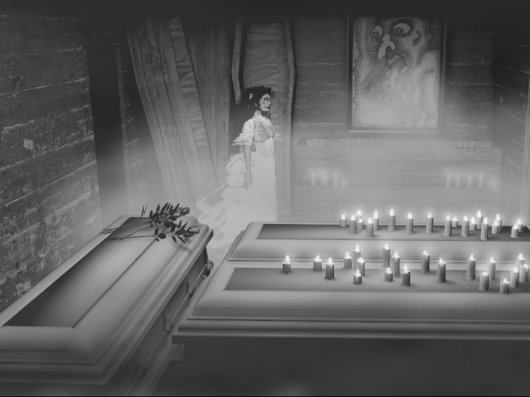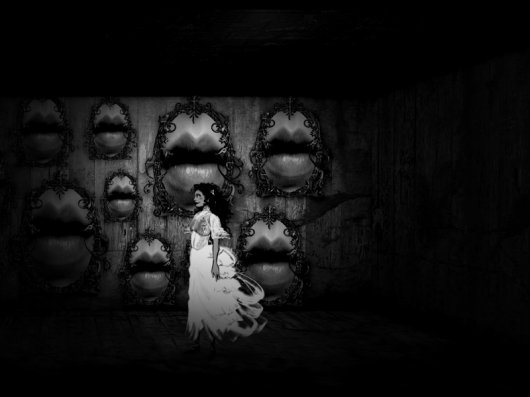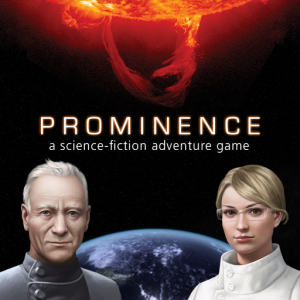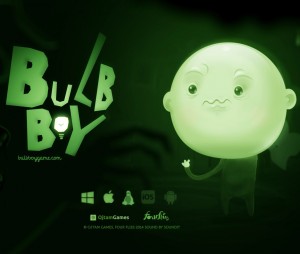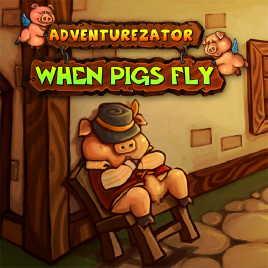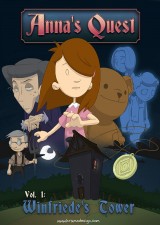Review for Downfall (redux)

Are you ready to dive into the meat grinder? In Downfall – or more specifically, the significantly remade version of Rem Michalski’s 2009 horror adventure, reimagined in the style of The Cat Lady – you’ll explore the depths of human emotion and raw relationships as you claw your way through unimaginable terrors hiding in a seemingly quiet countryside hotel. Though the gore will surely turn some people off and the tension can be unrelenting at times, making you wish for a few more moments of quiet character development, the well-integrated puzzles, innovative points of view, and strong storytelling will have you steeling yourself to open just one more door or turn just one more corner no matter the darkest ghouls and monsters that might be waiting for you.
Joe Davis grew up in a dilapidated neighborhood. Outside a squalid building, a sign hangs from a metal fence warning you against playing in this seedy area. Joe is excited to show off to a friend such macabre areas as the place where all the neighborhood cats go to die. As you begin to explore these sidescrolling environments, you’ll control Joe using the right and left arrow keys, with hotspots appearing as text prompts when you approach them. The up and down arrows allow you to interact with objects and collect applicable items as inventory, respectively. The down arrow also opens a small inventory bar at the bottom of the screen, within which you can scroll between objects and select one for examination or further use. Though simple, I encountered some frustration with this method, like when I inadvertently opened my inventory when I wanted to interact with something or vice versa. Even more cumbersome is using an elevator, where going down involves first pressing the up arrow to interact with the elevator panel and then pressing down to select the floor that you wanted, even if that floor was above you.
Fortunately, the easy movement controls and lack of cursor let you really immerse yourself in Joe’s world. While Robbie, Joe’s younger brother, goes out to explore what he thinks will be the find of the summer, Joe meets a beautiful young girl named Ivy. They connect in a playful push/pull way. Joe plies her with compliments, and Ivy responds without missing a beat. In their initial meeting, you learn that both are transplants, strangers in a foreign land. While Ivy is from Sweden, Joe is an American living in England. There are tentative forays by both to get to know one another better, and little motes of information float by in their dialogue hinting at deeper issues lurking below, such as the fact that Ivy is discovered sitting outside a café as her mother eats alone inside. There isn’t much time for them to become better acquainted, however, before a horrifying explosion rips Joe’s world apart.
A meeting such as this one, baptized in blood, is bound to leave wounds that scab over but never entirely heal, as Joe notes about his meeting with Ivy again when he is in his 20s. He is still mesmerized by Ivy’s beauty, her emerald eyes, and by the tragedy they've shared – so much so that they soon marry. When we encounter them again later, though, their marriage is creaking under stresses and strains. They are hoping to escape, both from the storms of their relationship and a real-life thunderstorm, as they enter the weary looking Quiet Haven Hotel. From the minute they meet the sultry hotel manager, Joe and Ivy know that something is not quite right. Ivy can hear terrible things and sees blood under the manager’s fingernails. Joe doesn’t quite know what to make of Ivy’s observations, but things are not off to a good start for the vacation that was supposed to save their marriage.
As they settle into their room, a sad affair with two double beds sitting as far apart from each other as two strangers on a midnight bus heading to the end of the line, the bickering begins. In the morning, Joe awakes to find that Ivy is missing. For the remainder of your time with Joe in Quiet Haven, you’ll help him investigate the sticky nooks and crannies of the hotel and interrogate the few oddball residents who may have information about Ivy’s disappearance.
The Downfall remake offers quite a cinematic presentation. Upon your initial entrance into Quiet Haven, you’re shown off-kilter, quick-cut shots of the lobby, the camera view switching from a black cat clock on the wall to an enormous stuffed elephant’s head to unsettling paintings gracing the hallway. And while there isn’t a ton of ambient movement in each scene, the animations that exist are used quite effectively: a wall of monitors flickers and skips and stutters, adding a frenetic tension to the atmosphere; a character walks down a hallway lined with mirrors and something unexpected appears as her reflection; a frozen pig carcass swings slightly in the frigid air of a room-sized freezer; a shot that cuts to real video of swarming maggots and bees provides a glimpse at madness squirming beneath the surface. I often found the different ways Michalski layered 2D drawings, 3D images, and actual video to be brilliant. One memorable scene has barely-there flickering X-rays overlaying an unnatural surgery room, very effectively upping the creep factor.
The game has an original score and soundtrack, heavy on the wailing, poignant guitars and raw screams interspersed with quieter piano moments. The music can be needlessly heavy-handed at times, especially during softer conversations, but sometimes it blares out intentionally, blocking out dialogue and signaling something so horrifying it defies description. The terrific use of sound effects adds yet another layer of horror. I’ve never given any thought to exactly how a brain might sound squishing back into a brain cavity, but I think now I do. And the plip, plip of blood dripping from an arm flung limply over a chair in the background underlines the tense conversation involving Joe about a relative’s death.
All of this blends together to deliver some of the most terror-fraught feelings I’ve had playing through a game. There were times when lights would shut down, or whispers, scratches, and bangs would crawl through my headphones into my mind, and then… oh god, no, something bloody rising from the darkness, arghh! It would have been easy to fill the game with simple jump scares, and there are plenty of those: doors suddenly swinging open with loud crashes, for example. But there are also suspense-laden scenes that happen with slow inevitability. In a dark room, you notice something out of the corner of your eye. It’s the tip of something metallic and sharp. It’s covered in red. Cautiously, you back Joe away. Slowly the head of an axe makes its way into the frame, edging closer to Joe. Scenes like this are unrelenting, ratcheting up the tension. As you get further into the game, some of the imagery is so horrifying, I hesitate to even describe them. I’m a fan of horror stories in general, but the abundance of gore in this game (open wounds, dismembered body parts, and gallons and gallons of gushing, leaking, and spurting blood) pushed me to my limits.
I’m actually amazed at how much horror Michalski managed with such a limited color palette and simple line drawings for characters. The scenes are black and white for the most part (with memories wan and palely awash in weak colors). Splashes and stains of vivid color appear here and there: a red bow dangles from the black lace of a woman’s skirt, a bloody red jewel sits on a temptress’s belt, a cat’s velvet red tongue peeks out from its mouth. And of course the gore explodes onto various scenes in bloody excess. The palette isn’t all blood, black and white, though. There are brief – too brief – moments when the cool blue sky peeks through clouds or the warm lavender and rose of a sun setting breaks across the horizon. Pale red flowers are a sign of hope, however weak.
But even without an excess of color, Downfall cleverly uses varying light levels to alter the mood. As you walk past a bank of windows, crackling flashes of lightning brighten the entire room around you. Have Joe walk down the stairs to a hidden room, and the view switches to first-person, the walls becoming a bright, clinically blinding white that dazes you before heading into the next location.
Much of the horror is conveyed through conversations Joe has with the various hotel denizens. The available dialogue options as you get deeper into the game provide you with increasingly difficult choices of how Joe should express himself. Is he patient and loving? Is he cold and callous? Is he insane? The dialogue doesn’t just document Joe’s apparent mental downfall, it also expresses those stress-filled internal conflicts anyone who has ever struggled to control their own anger and frustration can instantly recognize. Michalski explores a broken relationship where each person knows exactly how to hurt the other, whether by saying the most painful things or saying nothing at all. When first entering the hotel, Joe talks and talks, almost willing Ivy to speak. She has been silent for the entire ride. “So. You’re still not talking to me?” A long and heavy silence, followed by Joe, “Can we at least try not to make a scene in front of people. I don’t want to look like an idiot again.” Silence. “That’s right. Say nothing.” There are some conversations that revel in grim black humor. Joe regularly made deadpan observations that had me chuckling despite my fear, and one of the funniest conversations occurred in a place surrounded by death, each participant adding humor as well as an underlying menace.
Some dialogue choices will affect how the game ends for you. The ending I received appears to be the default outcome, but a final summary revealed that I may have missed some items even after multiple playthroughs. I did notice that the screen slightly glowed after making a conversation choice, but there is no direct feedback on whether that choice will have any consequences. The one time the game did provide feedback related to a choice I made in responding to a character, alerting me that she would remember, but I was never sure how that affected the story. It’s tempting to focus on making what you think the game thinks is the “right” choice, but for me it was better simply to choose the options that made the most sense given what I knew so far of Joe’s character. This led me to more realistic and relatable moments. When Ivy asks Joe what exactly about her he cared about, I chose the options that felt right to me. This allowed me to be genuinely surprised at Ivy’s reaction and to feel a sense of completeness when these choices echoed back to me later in the game.
You’ll learn about Ivy, Joe, and Agnes, a woman Joe meets at the hotel who ends up helping him in his search, through fully voiced dialogue – a major change from the 2009 version, which had no voice acting at all. There is quite a lot of speech to listen to, but you can use your space bar to click through the dialogues faster. For the most part, the voice acting is subtle and realistic. The few weak spots are the actors playing young Joe and his brother Robbie. Slow speech and odd inflections made for strangely spooky voice readings, which I’m not convinced was intentional. At times you get to play as Agnes, and her bright and carefree tones are a welcome relief from all the angst and brooding, making her a wonderful foil for Joe. Joe himself manages to convey love, barely restrained anger, frustration, and grief quite well. Ivy, the brief times you hear from her, has a voice saturated with sadness and weariness.
The surreal Quiet Haven Hotel is semi-inhabited, and you will meet four incarnations of a woman named Sophie; a smarmy boyfriend named Harrison, whose voice oozes sleaze; and a crazy German doctor named Doctor Z doing even crazier experiments. A woman described as the Queen of Maggots also appears in dream sequences for Agnes and Joe, and her vocal performance (along with a healthy dose of sound distortion) did a superb job of filling me with dread. And to my surprise, a major character from The Cat Lady makes a welcome appearance. It’s not merely a cameo, either, but a fairly substantial role that added a really interesting dynamic to how I actually wanted the game to end.
Another integral character is Sophie, a woman in the room next to Joe and Ivy’s who the manager warns you absolutely not to disturb. Of course, you do go on to disturb her with your arguing. Sophie was an enigma for me. You don’t learn very much about her backstory and her issues mimic those that Ivy is experiencing. She doesn’t appear to be a normal hotel resident, and that feeling notches the dial up to 11 when she explains that the only way you can find the missing Ivy is to kill four memories of herself. Naturally, at this point I began to question Joe’s sanity. Was this real? Had he and Ivy just happened to find a hotel filled with monsters? Who exactly is Joe being asked to kill? Are these memories real people?
To find Ivy, you must decide how to comply with Sophie’s request. Locating these memories and determining how to kill them involves a variety of inventory puzzles, though not your run-of-the-mill adventure game solutions: you’ll have to figure out uses for disarticulated mannequin arms, cat skulls, and severed human heads. Thankfully, there is no pixel hunting as hotspots immediately light up as you walk back and forth through hallways and rooms, though areas that might not have been interactive at first may become so after you’ve met someone new or learned a key piece of information. Very occasionally you will combine items outside of your inventory in a specially designated crafting area. You also need to interact directly with the environment, whether by turning on pieces of equipment or determining which entrance out of multiple options to enter. There is one maze where you navigate Agnes through a series of similar-looking hallways. I figured it out by trial and error, but the side-scrolling nature of the game made navigating directions a bit challenging, though not show-stopping. Regardless of type, the game’s puzzles are all fairly straightforward and easy. Nothing blocked my progression, which I didn’t mind at all as exploring the floors of the hotel and its immediate outdoor surroundings, like a large house in the countryside, is a slow process with no access to any quick travel mechanics.
Joe notes during one of his reveries that in his dreams he visits a quiet haven. Once again this raises the question of whether this entire visit is all in his mind. Many of the quirky changes in perception point to the unreality of what you’re experiencing. At one moment, Joe notices a lone TV sulking quietly in a room. He turns it on and as you watch the screen, suddenly you’re moving Joe in the TV! In another scene, Joe is walking through a hallway with Agnes. He moves forward and Agnes slows down and moves out of frame. He sees Ivy and something horrific happens. But when he backs away and both he and Agnes re-enter the scene, the vision is gone. Was he imagining things?
Whether Joe’s experiences at Quiet Haven are real or imagined is not a question to ponder lightly. I found myself continually returning to these doubts about the game’s reality, because you’re asked to accomplish a series of increasingly morally dubious tasks. "It’s just a game," you might say to justify your deeds, or speculate that none if this is real. But how do you know, and how far will you go in Joe’s quest to find Ivy? And if you see these requests as real, what have you accomplished when you’ve finished the tasks? What have you become?
At a certain point, your only choices are between awful and terrible. It’s such a bleak turn of events that I became weary of going forward. A character attempts to facetiously explain that the hotel was built on an ancient Indian burial ground. She laughs when she thinks Joe believes it, mocking his attempt to understand the insanity around him. But by then I felt a bit mocked myself. It feels as if some of the character backgrounds and motivations have been streamlined too much, moving in the direction of a horror tone poem instead of a stab at realism. This isn’t helped by the fact that large portions of Joe and Ivy’s relationship are merely implied, having lurched past the better times and straight to when their relationship was already on the downslope. A bit more time spent fleshing out the couple's relationship, adding more quiet moments (there are some, just not enough) when they were happy would have gone a long way toward making the pain of trying to regain what was lost more meaningful.
These few narrative complaints aside, Downfall is a highly compelling game overall, offering a variety of different ways of experiencing its story with nicely integrated challenges and presented with Michalski’s now-familiar distinctive style. I felt more horror than I ever have before playing a game, but despite my terror and the over-indulgent gore, I couldn’t stop playing. Having not played the original version of the game I cannot offer a proper comparison between versions, but for horror aficionados who aren’t afraid of investigating the complexity and depths of the human mind and experience, I can say unequivocally that the Downfall remake is a game well worth checking out.
Note: The original Downfall and 2016 remake were reviewed by different people, and should be considered standalone critiques. Scoring differences are not solely reflective of the upgrades between versions.





